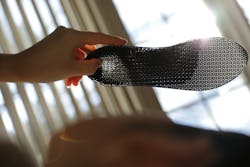3D printing allows foot orthotics startup to get to the 'sole' of the matter
By Karen Hanna
A sore foot can be debilitating. But a startup creating orthotics using 3D printers is taking steps to ease foot pain while overcoming some of the cost and slow turnaround times that have hobbled the custom insole market.
“We decided that we were going to bring the digital process to the orthotics industry and really break down three of the main barriers that we're seeing today, and those are high cost, poor fit — not just for you, but also to your shoes — and then, inaccessibility. It's really hard to get custom orthotics today,” said Mike Schmid, the founder and CEO of inStryde, an online retailer of 3D-printed orthotics tailored to customers’ feet.
Using L1 printers from Carbon, the company has been shipping orthotics since late 2019. Recently, it updated its proprietary software, SmartFit, which customers can access through their smartphones to perform scans that provideThe company has “gone through a number of product revisions over the past few months to improve overall support, comfort and performance,” Schmid said.
Based on submitted scans, Carbon's Design Engine software then designs a lattice structure that matches individual users' needs, said Kelley McCarroll-Gilbert, business development director for the 3D printer maker.
“We can vary stiffness throughout to match certain characteristics and needs that they have. And then we send a file to our production partner, and they print it out on this elastomeric polyurethane material developed by Carbon," Schmid said.
An engineer with a background in the aerospace industry, Schmid began looking for a new way to make insoles after walking the proverbial mile in the shoes of someone with hurting feet. He's an ardent soccer player, and when a doctor advised him to look into custom orthotics to relieve a bout of plantar fasciitis, he initially chose to play hurt.
“I'm a frugal person by nature, but the custom orthotics were going to cost me $600, and they were going to take two months to get. And I was like, ‘You know what? I don't need these.’ And a few minutes into my next game, I really injured the plantar fascia in my right foot,” he said. “So, I ended up biting the bullet, paying the $600, getting the custom orthotics, and, at the end of the day, they fit me really, really well, but they were so thick, there were so many different materials layered together, that they didn't fit into my soccer cleats, so I couldn't wear them while I was playing.”
Out of that experience, inStryde was born, offering orthotics ranging from $129 a pair to $229 for two pairs.
In starting up inStryde, Schmid found Carbon’s s Digital Light Synthesis (DLS) printing process and materials fit like a glove.
The DLS process uses ultraviolet light to cure special resins — most developed by Carbon itself.
It allows inStryde and its contract printing firm to make quick iterations, without the costs and delays associated with traditional manufacturing approaches, McCarroll-Gilbert said.
"Additionally, there is the ability to scale quickly, create custom products in a highly streamlined manner, with high-performing and durable materials. For a product like inStryde’s insoles, the ability to customize at scale is key — both on the shape and size of the insole and with the potential for variable density responses in a single printed part," she said.
As one of the doctors who volunteered to provide an expert perspective to inStryde, podiatrist Deep Patel praised the company’s end product. A board-certified doctor of podiatric medicine and foot and ankle specialist, he believes inStryde’s orthotics are sufficient for most foot-pain sufferers, while representing a huge step up from over-the-counter inserts.
3D printing has opened up new possibilities for the market, providing “a good balance of cushion and shock absorption and bounce back, due to its lattice technology,” Patel said.
“It is very close to a custom-molded orthotic that you would get in an office. The only difference is, in an office, a lot of times you're using older technology where you're stepping in a foam box or doing a plaster mold of your foot. But, at the end of the day, those differences are kind of minimal for most people that don't have an extreme foot type, like a very high arch or very flat arch. Most people are right in the middle,” he said. “[The inStryde process] is super because it eliminates the need to make extra trips and spend extra money, and you get a very customized product to your foot.”
The insoles have Schmid back on his feet, playing soccer again.
“Pre-orthotics, when I was playing competitive soccer, plantar fascia injury is no joke, it's very painful; it takes a lot of PT to get on the other side of. It’s a very nagging injury. Post-inStryde, I haven't really injured it,” said Schmid, who walks 1.5 miles each way to and from his office in Winston-Salem, N.C.
Patel, too, proclaimed an optimistic prognosis for the startup.
“I think for an initial product line, this is ... going to be very successful, and I think people are going to benefit from it tremendously,” he said.
Karen Hanna, senior staff reporter
Contact:
Carbon Inc., Redwood City, Calif., 650-285-6307, www.carbon3d.com
aAbout the Author
Karen Hanna
Senior Staff Reporter
Senior Staff Reporter Karen Hanna covers injection molding, molds and tooling, processors, workforce and other topics, and writes features including In Other Words and Problem Solved for Plastics Machinery & Manufacturing, Plastics Recycling and The Journal of Blow Molding. She has more than 15 years of experience in daily and magazine journalism.

